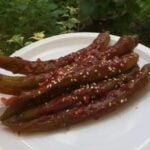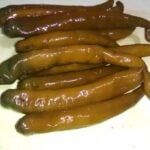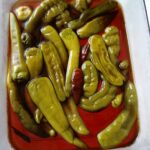This is one of my most favorite kinds of jangajji (Korean pickles). It’s made with green chili peppers and tastes salty, sour, spicy, and a little sweet. It’s very crispy and crunchy. Biting into a pickled pepper with a spoonful of warm rice and having the salty brine splash out with a snappy crunch is just irresistible for me. In general, chili peppers hold a special place in Korean cuisine and are loved by pretty much everybody. We use them in many many dishes.
These days, between summer and autumn, green chili peppers are in season. Peppers are cheap, plentiful, and at their peak, so I buy lots of them and make lots of pickles. I eat them with almost every meal!
I remember watching my grandmother make green chili pepper pickles when I was a kid. She made a few kinds: chili peppers pickled in a soy sauce brine, chili peppers pickled in a fish sauce brine, and also chili peppers pickled by pushing them deep into her crock full of homemade doenjang. I can still remember the taste of rice with my grandmother’s pickles.
This version I’m showing you today is one of the least salty varieties of gochu-jangajji that I know. I plan on posting more chili pepper pickle recipes over time, because they are so delicious and a good thing to have in the fridge when you want to put together a quick, tasty meal or even just a spicy snack.
Ingredients
- 1 pound green chili peppers, washed and dried
- 3½ cups water
- ½ cup soy sauce
- ¼ cup kosher salt
- ¼ cup white vinegar
- 3 tablespoons turbinado sugar
Also get some pebbles, clean and dry them, and put them into a plastic bag.
Directions
- Cut the stems the peppers, leaving a ½ inch on the top

- Make a hole with a toothpick or fork on each pepper, just under the stem. These holes will allow the brine to seep into the pepper.

- Put the peppers into a glass jar that can hold at least 8 cups.

- Combine the water, soy sauce, kosher salt, vinegar, and the sugar in a pot. Stir to dissolve the sugar. Cover and bring to a boil over medium high heat. When the brine boils and bubbles vigorously on the surface, pour it into the jar of green chili peppers.


- Keep the peppers submerged in the brine by weighing them down with your bag of pebbles (or anything else handy).

- Cover and let it sit at room temperature for 24 hours.
- 24 hours later open the jar, take out the pebbles, and pour the brine out of the jar into a pot.

- Boil the brine vigorously for about 15 minutes.
- Remove from the heat and let cool thoroughly. If you want it to cool faster, place the pot into a bath of ice water but be sure not to splash cold water into the brine.
- Pour the cool brine back into the jar. Cover and refrigerate for 1 week or more before eating.
Three different ways to eat gochu-jangajji:
1. As a simple side dish with rice.
This is the easiest way to enjoy them. Simply put some peppers and brine in a shallow bowl, sprinkle some sesame seeds over top, and serve with rice. You can add more side dishes if you want.
2. Mixed with seasonings.
- 1 pound pickled green chili peppers
- 5 garlic cloves, minced
- ¼ cup hot pepper flakes
- 2 tablespoons soy sauce
- 1 tablespoon rice syrup
- 1 tablespoon olive oil (or vegetable oil)
- 1 teaspoon toasted sesame oil
- 1 tablespoon sesame seeds
Combine garlic, hot pepper flakes, soy sauce, rice syrup, olive oil, and toasted sesame oil in a bowl. Mix well with a spoon. Add the pickled peppers to the seasoning mixture. Mix well by hand. Sprinkle sesame seeds over top and serve it right away as a side dish for rice, or refrigerate it for up to 3 months in an airtight container.
3. Make bibimbap (aka mixed rice).
Chop 2 pickled peppers into small pieces and put them into a bowl. Add 1 minced garlic clove, 1 teaspoon hot pepper flakes, ½ teaspoon soy sauce, 1 teaspoon rice syrup, 1 teaspoons toasted sesame oil, and 1 teaspoon sesame seeds. Mix well.
Roast a sheet of gim (seaweed paper) until both sides are very crispy.
Put a serving of warm rice into a large wide-mouth bowl. Add some or all of the chopped and seasoned mixture, crush the roasted gim and add it too. Mix well with a spoon and eat. You can add extra sesame oil, too.
Maangchi's Amazon picks for this recipe
It's always best to buy Korean items at your local Korean grocery store, but I know that's not always possible so I chose these products on Amazon that are good quality. See more about how these items were chosen.











































If we don’t have pebbles (and can’t think of anything else that’s sanitary to use) as a fermentation weight, how long would I have to wait if I just put the peppers straight in the fridge in the brine?
Hi Maangchi. I might have totally messed up and poured the pickling liquid onto the chiles while it was still hot after the second boil. Do you think it will turn out okay or should I discard and start over? Thank you for your recipes.
It will turn out okay – probably not as crunchy as intended, but perfectly safe (and yummy!) to eat.
Thank you!
Oh – emojis don’t seem to work…
Thumbs up!
Sanne, thanks for the reply on behalf of me! You are one of my awesome and avid readers. Love you…
Your comment just brought tears of joy to me.
Thank you so much! Back at you!!!
@WorldEater, yes, just as sanne said the pepper pickles may go soggy but it will be ok to eat. Keep it in the fridge and eat it fast if you feel the peppers get soggy. Good luck!
Hi, I’d like to know how to make the version where the chilies are put in doenjang! Is the process the same? When do you add the chilies to the doenjang? Thanks … love your recipes.
I have a question I made these and today I was on step 8-10. After boiling the brine there is not enough left to even cover half of the peppers……….do I just add more soy sauce and vinegar? Surely we are not supposed to refrigerate for a week when the brine doesn’t even reach up half of the peppers? anyone help?
Dear Maangchi!
I made these yesterday but missed adding the salt because it’s not included in any step in the recipe directions and I didn’t watch the video. :(
Can I add the salt in today when I take out the brine to reheat it?
I also see this many times with onions, so I included onions together in the jar.
See full size image
Yes, at step 8, add 1/4 cup salt to the brine, stir, and boil.
When you watch my video, you will see me adding salt. All these years later I found the mistake thanks to you! I just fixed it. By the way, your pepper and onion pickles look good!
We have a variety of peppers in the garden. I’m going to try this recipe with different types and see what happens.
See full size image
OMG I will share this in my November newsletter! Beautiful different types of peppers! Gorgeous colors with different shapes, and you organized them so well to take this photo. Everything makes me happy, I’m sure a lot of people will feel the same way!
Annyeong Maangchi,
After 6 days my Gochu-Jangajji was ready! First I tried some as a snack, and they turned out even tastier than I had expected! Of course, the red chilies from Ecuador were quite spicy, but the bellpepper was very mild, had absorbed some spiciness from the chilies, though. I guess, people that prefer a totally nonspicy version could make Gochu-Jangajji from green (or other color) bellpeppers only. I´ll try this out next time and let you know.
As mentioned in my former comment, I made Samgyeopsal-gui, and added the Gochu-Jangajji in stead of Ssamjang: it combined perfectly, and the result was mouthwatering! Today I had made a fresh batch of Yangnyeom-Tongdak-sauce, and used the rest stuck in the wok to season the Gochu-Jangajji: yummie!
See full size image
Annyeong Maangchi,
Made Gochu-Jangajji yesterday, just finished the brine cooking process today, and got the jar in the fridge. Can hardly wait till next week, to try it. Planning to make Samgyeopsal-gui next week, and have the plain and the seasoned Gochu-Jangajji with it, in stead of Ssamjang.
I didn´t have green Korean gochu available, so I used red chilies (from Ecuador), and also green sliced bell pepper (for the color and not so spicy). Next time I´m in Quito, I´ll see if they have the Korean gochu in Seoul Market. Then I´ll save the seeds, and try to grow my own.
See full size image
Thank you very much for your delicious recipes. I love them
See full size image
Awesome!
Hi Maangchi can’t wait to make this recipe!!! i love my spicy and i love my peppers. Going to make a big batch so I can share with my family. Thank you for all your wonderful recipes. I never would’ve been able to cook Korean food if it wasn’t for you!
By the way, is it fine to just double the recipe to make more? I will probably need a huge jar
Yes, you can double, tripe, or quadruple the recipe. Good luck!
Hi maangachi, i want try making this recipe. But, i see a little different when get some gochu-jangajji from korean aunty, there is onion, garlic, green chillies in one jar. My question is, that brine recipe same with this recipe? And will be a problem if add garlic or onion ? Thank you for your answer~~
Hello my Korean mom! I made these yesterday, and today was my day to boil the liquid and return to the jars. I have a problem though. After I boiled vigorously for 15m, I have only about half my liquid left. I forgot to cover it!
What do I do now that I only have half the liquid?
I have this same problem. After boiling the liquid for a second time I don’t have enough to cover the peppers. What do I do?
Hi Inches and hardbap!
You can make more salty brine and add it.
Hi Maangchi,
We were at an annual gathering yesterday evening (well, a BBQ ;-)), and I brought some Korean stuff (as usual).
Your gochu-jangajji was a big hit and I recommended your website.
Bye, Sanne.
Hi Sanne,
I’m happy to hear that your gochu-jangajji was a big hit! You are such a great cook!
A few days ago, at a house-cooling ;-) party – the same.
The gochu-jangajji keeps very well, one year old (I made a giant batch) and still perfect!
And thank you very much for the compliment!
Great! I’m very happy to hear that you got some compliment from your friends!
Hi Maangchi, I was wondering if you could reuse the brine to make more jangajji?
Thank you for this recipe, Maangchi! I love these as ban chan. And the “squirt” in the video is so precious! Squirt! I love it!
I ran out of my gochu-jangajji now. I miss the “squirt”, too! : )
I have tried for ages to make this. A local Korean grocery store, Arirang Oriental Market, makes it and sells it, but so expensive ($16/pound). Now with this recipe it is perfect! I have some in the fridge, but it won’t last! Thank You!!!!!!!!!!!
hi maangchi-shi can I use apple cider viniger instead of white viniger?
and how long can I keep it……………I mean will it go bad quickly?
plz I need ur reply quickly!!!
Yes, you can use apple cider vinegar, too.
HOW long can I keep it?
does it have to be keept in the refrigerator ?
I don’t have fridge. so without it how long can I keep it?
I’m sorry to say that you need to keep this in the fridge. If not, the pickles will go soggy easily.
Maangchi ssi what do you do with brine when it’s done its job?
Thanks,
Ima
Hi Cutemom,
I have successfully used it to make Mul-Kimchi.
Bye, Sanne.
Thanks for the info sanne.
Hi Maangchi,
One week ago, we entertained a young Korean couple who were on their trip through Europe. Since they’d been in Europe for two weeks then without kimchi(!!!), they were so happy to get different kinds with samgyeopsal, ssam and bap – and gochu-jangajji ….
It went that way: The young husband took a gochu, one bite, went “OMG, it’s sO HOT! SO HOT!!!” – and the next bite. And several gochu. ;-)))
Of course, I recommended your site to them!
Bye, Sanne.
this is my favorite kind of “kimchi”… i asked you to make this like sooooo long ago! lol i can’t tell you how excited i am that you did! thank you so much, maangchi! :D
in the korean stores, the peppers come coated in the pepper sauce & they have shredded carrot and green onions.. and on one of the packages it said it used honey & ginger.. can you use honey instead of rice syrup if you don’t have the rice syrup?.. :) and is adding carrot, ginger & green onions okay? :)
when i bought this huge case of this stuff, it costed me like $50.. and at first the peppers didn’t taste very good (to me). they were very salty & briney… but after about 6 months in the fridge, they were absolutely phenomenal. oh my goodness, lol,, i can’t wait to make this!!!! it’s my favorite!!!
Hi Maangchi,
I’ve got more gochu now!
How did your Halmoni prepare the gochu (besides washing and trimming ;-)) before putting them in her doenjang? Just putting a hole in them? Was it “fresh” doenjang or nicely aged?
I don’t need a video right now, just a general description.
We had that kind in Andong at “P’aldo”, a small traditional (not a tourist-fancy one) restaurant near Andong-yeok.
Bye, Sanne.
She soaked the peppers in salty water for a week and then squeeze out the brine before she put them into her fermented soy bean paste. But her bean paste was stored in her huge earthenware crock.
Hi Maangchi,
thank you for your quick reply!
5% salt, I guess? The crock is no problem; I’ve got two for “Sauerkraut” and kimchi. Different to the Korean ones, but useable. :-)
How long until ready? 1 month? 2?
I can wait; made tongchimi several times … and manul changachi – the older, the better!
Bye, Sanne.
Hi Maangchi!
I prepared 2 pounds of gochu (salt-water, 5%; 1 week – they kept their color nicely!), mixed them thoroughly with 200 g of doenjang and put them in a small earthenware pot that held traditionally manufactured doenjang/gochujang before. Of course, I pressed each handful down to remove any excess air!
I “recycle” the now *hot* salt-water for making kat mul kimchi. The radishes are cleaned, cut and soaking; the kat is washed and drained – a lot to do today!
And I will prepare buchu-kimchi, too! Again; that, we do eat a lot.
Bye, Sanne.
Annyong-hasseyo Maangchi,
Thanks for your answer to my Woo-guh-ji tang question! Can I ask another? What green or greens are traditionally used in the woo-guh-ji tang recipe? Not many people on the Internet have this recipe, I found only two. Both people used different greens. My mom is Korean, from Inchon but she cannot remember for certain what they used because she rarely cooked when she was a young lady, they had servants. She only started cooking when she moved to the USA. Kamsahamnida Maangchi! Annyonghi-kjeseyo
woo-guh-ji is made of napa cabbage.
Hi Maangchi,
I grew some Korean hot peppers this year and they are so, so hot! I love it! The skins are thick and this is all that I don’t like but they are so hot and spicy and I like this. Thanks for your recipe because I needed something to do with all of these peppers because I cannot give them away. :) No one eats as spicy as me! Anyhow, thanks for your recipe, now I have a way to save them! Can you post a wooguhji tang recipe? It is my favorite! I am sure many people would love this soup, it is the best! What kind of greens do you use in your woo-guh-ji Galbi-tang? Do you use napa cabbage and something else?
Thanks, Jaye_sc
“What kind of greens do you use in your woo-guh-ji Galbi-tang? Do you use napa cabbage and something else” yes, you could use napa cabbage or radish tops. And also you could use chard, too.
Done!
The amount of brine was exactly right for the empty twist-off jar of pickled gherkins (1.7 quarts) that I’m using. No need to press anything down at the moment. No space left for pebbles. :-)
Hi maangchi!
Thankyouthankyouthankyou!
I have a bag (500 g) of spotless, fresh and *hot* put-gochu right here and will prepare 고추장아찌 tomorrow. One of my husband’s favourites!
Bye, sanne.
Hi Sanne,
Hope your jangajji is being soaked in the brine nicely in the fridge! : )
Hi Maangchi,
“Hope your jangajji is being soaked in the brine nicely in the fridge! : )”
Not yet – the brine is “vigorously boiling” right now.
It smells nice – but I just fled the kitchen nonetheless! ;-)
The gochu in their jar are in the fridge to give them a cool start.
When in the cooled-down brine, I will cover them with disposable Korean bowl-covers – I bought lots of them 8 years ago.
Bye, Sanne.
Hi Maangchi,
OMG – four weeks already!
Today, I made version number two. Big success! Our Korean guests were really impressed. Spicy, crunchy – delicious!
Btw: I used sugar instead of rice syrup and neutral vegetable oil, not olive-~.
Bye, Sanne.